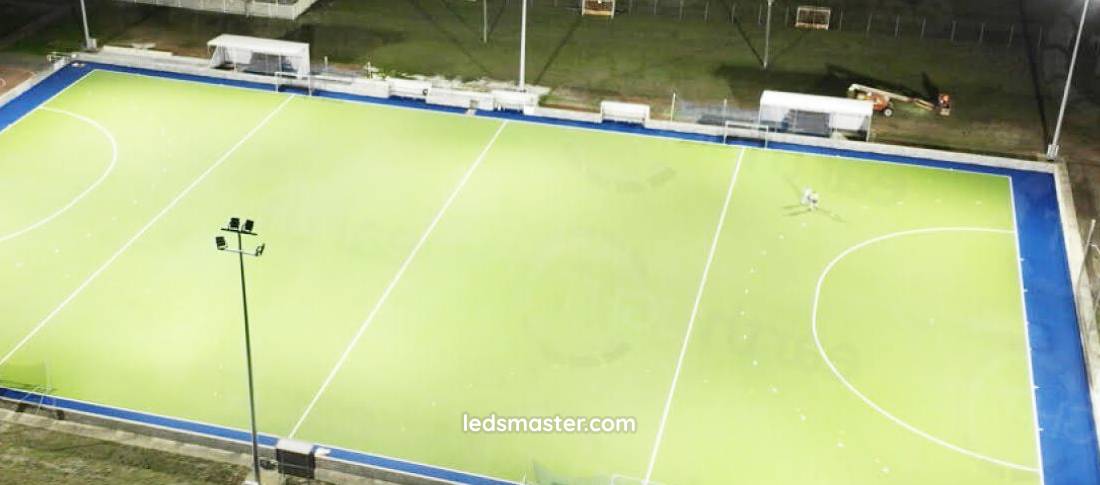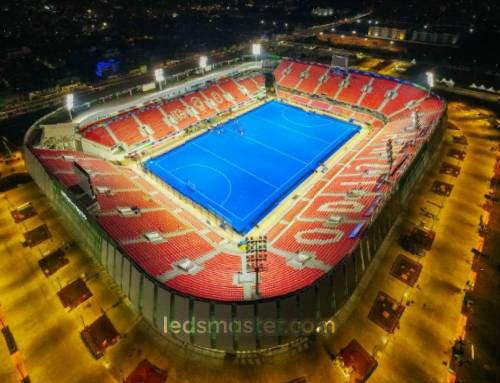Designing and installing a lighting system for a field hockey pitch involves more than simply choosing a few light fixtures. It requires careful consideration of various factors, from the size of the field to the type of lighting technology used. Additionally, the costs associated with installation, maintenance, and energy consumption can vary widely.
Get your complimentary lighting design today
Lighting a field hockey pitch involves numerous considerations and various costs. Whether it’s for a professional venue, a recreational facility, or a school ground, having the proper lighting system in place ensures players have a safe and enjoyable environment. The installation, maintenance, and operational costs of field hockey pitch lighting can vary depending on a variety of factors. Understanding these costs is crucial for any facility manager or organization planning to install lighting.
| Cost Category | LED Lighting | Metal Halide Lighting | Halogen Lighting |
|---|---|---|---|
| Initial Setup Costs | $40,000 – $100,000 | $20,000 – $50,000 | $10,000 – $30,000 |
| Monthly Electricity Costs | $500 – $1,500 | $600 – $1,800 | $700 – $2,000 |
| Annual Electricity Costs | $6,000 – $18,000 | $7,200 – $21,600 | $8,400 – $24,000 |
| Annual Maintenance Costs | $500 – $2,000 | $2,000 – $5,000 | $2,500 – $5,500 |
| Bulb Replacement (per year) | Low (typically not required for years) | $500 – $1,000 | $500 – $1,500 |

Table of Contents
ToggleThe initial setup costs for field hockey pitch lighting can vary greatly based on several factors, such as the size of the pitch, the type of lighting used, and installation requirements. For a standard full-sized field hockey pitch, the initial cost can range from $20,000 to $100,000 or more.
For example, LED lighting systems, which are more energy-efficient and have a longer lifespan, typically cost more upfront. The installation of LED lights can run between $40,000 and $100,000, depending on the quality of the fixtures, number of poles, and installation complexity. On the other hand, a metal halide lighting system for the same pitch might cost between $20,000 and $50,000, with halogen lighting systems generally being cheaper, though less efficient.
The ongoing operational costs for lighting a field hockey pitch consist of electricity bills. The cost of running the lights depends on the wattage of the lights, how many are installed, and how often they are used. LED lights consume less power than metal halide or halogen lights, making them the most cost-effective choice over time.
Assuming a field uses approximately 100,000 watts of lighting, running the system for an average of 5 hours per night for 3 days a week can result in monthly electricity bills of $500 to $1,500, depending on energy rates in the area. The total annual cost for electricity can range from $6,000 to $18,000 for a field with LED lighting, or even higher for other types of lighting.
Maintenance and repair costs can range from a few hundred dollars to several thousand annually, depending on the type of lighting system installed. LED lights generally require less maintenance, but they still need periodic inspections and occasional fixture cleaning, with costs typically ranging between $500 and $2,000 per year.
For metal halide or halogen lighting systems, maintenance costs tend to be higher. Bulb replacements alone can cost up to $1,000 annually, with additional costs for inspections and wiring checks. In total, maintenance for these systems can cost $2,000 to $5,000 per year.
The size of the field hockey pitch determine the lighting costs. A standard field hockey pitch typically measures 100 meters long and 60 meters wide. The larger the area, the more lighting will be needed to ensure even illumination across the field. For example, a pitch of this size requires more floodlights and greater wattage per light compared to smaller pitches. The spacing of these lights also needs to be considered, as too few lights can result in uneven lighting, while too many can lead to wasted energy and unnecessary expenses. Thus, the larger the field, the higher the upfront and ongoing costs.
The type of lighting installed on a field hockey pitch will affect the total cost. There are several options available, with each offering distinct benefits and drawbacks in terms of initial cost, energy consumption, and longevity.
LED floodlights are becoming popular for sports fields due to their energy efficiency and long lifespan. LEDs typically last for around 50,000 hours, which means they require fewer replacements compared to traditional lighting. Additionally, they consume less electricity, leading to lower operating costs. However, LED lights come with a higher upfront cost. For a field hockey pitch, LED floodlights can range from $500 to $2,500 per unit, depending on the wattage and brand. When multiple units are needed to illuminate a full-sized field, the costs can add up.
Metal halide lamps have been a popular choice for sports lighting for years. They provide bright, white light and are relatively affordable compared to LED lighting. However, they tend to have a shorter lifespan—usually around 20,000 hours—and consume more energy, leading to higher operational costs. For a full-sized field hockey pitch, metal halide lights can cost between $200 and $1,500 per unit, with the total number of fixtures depending on the layout of the pitch. These lights also require more frequent maintenance, adding to their long-term costs.
Halogen lights, while less common for field hockey, can still be used in smaller or temporary setups. Halogen lamps produce a warm, bright light, but they also generate a significant amount of heat, making them less efficient than other options. Like metal halide, halogen lamps need to be replaced more often and use more energy. Halogen lighting units typically cost between $100 and $500 each, though they are rarely used for full-size field hockey fields due to inefficiency.
Solar-powered lighting is an environmentally friendly option that can help reduce electricity bills and make the facility more sustainable. While the initial investment for solar lighting is generally higher due to the cost of solar panels and battery systems, the operating costs are very low. Over time, solar-powered lights can offer substantial savings, especially in areas with abundant sunlight. The cost of a solar-powered system for a field hockey pitch can range from $10,000 to $50,000 depending on the system’s size and the location.
The installation process for field hockey pitch lighting involves several components, including the purchase of fixtures, poles, wiring, and the labor required to set up everything. For a full-sized field hockey pitch, the installation process can cost between $10,000 and $50,000 or more, depending on the type of lighting used and the complexity of the installation.
Labor costs can vary based on location and the expertise of the contractors, but generally, professional installation is required to ensure that the lights are mounted securely, wired correctly, and meet all safety regulations. Groundwork for pole installation, trenching for cables, and any necessary structural modifications can also add to the cost.
Additionally, depending on the location and the terrain of the pitch, some sites may require more intensive preparation work, such as reinforcing poles to withstand wind or weather conditions. This added groundwork can increase both time and costs.
Ongoing maintenance is another consideration when budgeting for field hockey pitch lighting. The maintenance costs vary depending on the type of lighting system and how often the lights are used. LED lights, with their long lifespan, generally require less maintenance than metal halide or halogen lights, which need more frequent bulb replacements.
For LED lights, maintenance primarily involves cleaning the fixtures to maintain brightness and efficiency. Occasionally, electrical systems may need to be checked or replaced. Metal halide and halogen lights require more frequent attention. Bulb replacements for these systems typically occur every 3 to 5 years, and the costs for this can range from $50 to $200 per bulb, depending on the size and type.
In addition to lighting replacements, field lighting systems require periodic inspections of wiring, transformers, and other electrical components. Regular upkeep can range from $1,000 to $3,000 per year depending on the complexity of the system and how frequently the lights are used.
Many regions and governing bodies set specific guidelines for the lighting of sports facilities. For example, field hockey lighting needs to meet specific standards regarding uniformity, brightness, and safety to ensure that athletes can play without the risk of injury. The International Hockey Federation (FIH) and other local sports organizations provide specifications for lighting systems that may affect the cost. These guidelines could necessitate more advanced or higher-powered lighting systems to meet competitive standards, increasing both initial and ongoing costs.
In some regions, there may be requirements related to energy efficiency, which could lead to higher initial investment in LED lights but result in long-term savings. Depending on the location, the lighting system may also need to comply with environmental regulations, which could make solar-powered lighting a more viable option in some areas.

Switching to LED lights can drastically reduce both initial and long-term costs. While the upfront costs of LED lighting systems may be higher, their energy efficiency and longer lifespan result in lower electricity and maintenance costs over time. LED lights consume 40% to 60% less energy than traditional metal halide or halogen lamps, leading to considerable savings on power bills. Furthermore, because they last much longer—up to 50,000 hours—they need fewer replacements, reducing ongoing maintenance costs.
For those looking to reduce energy consumption further, solar-powered lighting systems offer a promising option. While the initial investment is high, with costs ranging from $10,000 to $50,000, solar lighting can dramatically reduce electricity costs. Solar lights harness energy from the sun, storing it in batteries for nighttime use. This setup eliminates ongoing electricity costs, making it a sustainable choice for facilities located in sunny regions.
Another way to reduce energy consumption is through smart scheduling of lighting systems. Implementing automatic timers or dimming controls can help manage the hours the lights are in use, ensuring that they only operate when needed. Additionally, using lighting management software can help optimize lighting levels based on the activity and time of day, preventing overuse of electricity. Reducing the overall number of hours the lights are on can lead to considerable savings over the course of a year.
The costs associated with lighting a field hockey pitch are influenced by several factors, including the size of the pitch, the type of lighting chosen, installation requirements, and ongoing maintenance. While initial setup costs can range widely depending on the lighting system, the long-term operational and maintenance costs are also substantial. LED lighting, despite its higher upfront investment, offers considerable advantages in terms of energy efficiency and longevity, making it the most cost-effective option in the long run. Alternatives like solar-powered lighting, though more expensive initially, provide significant savings on electricity over time, especially in sunny regions.